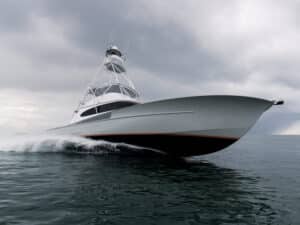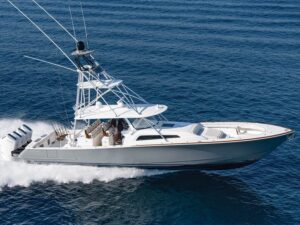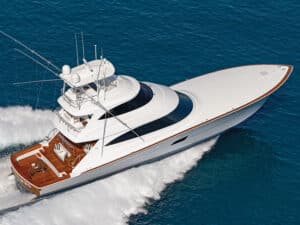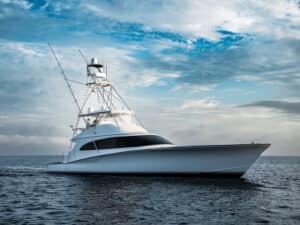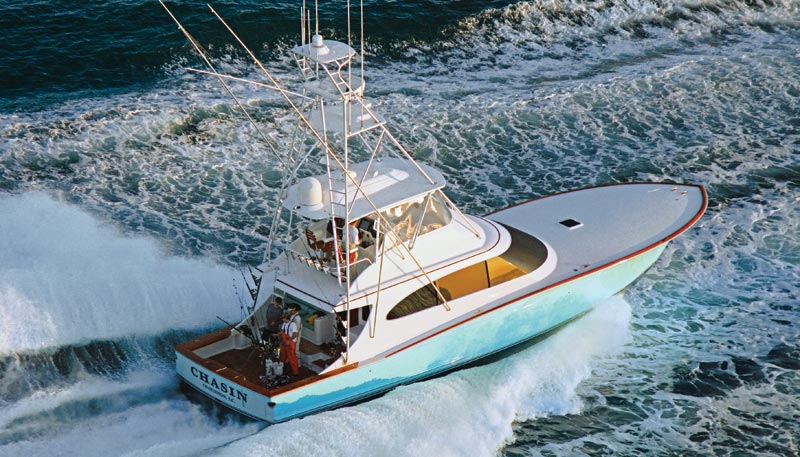
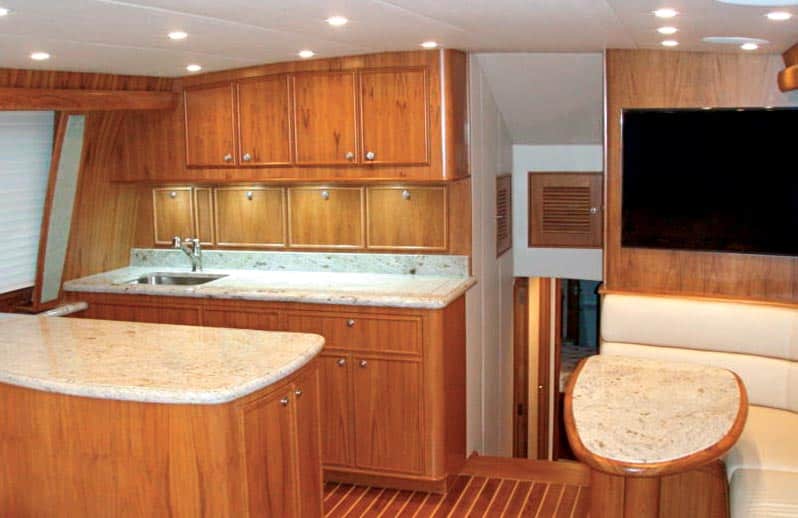
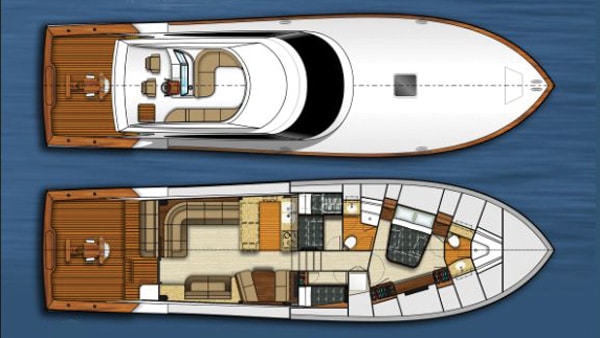
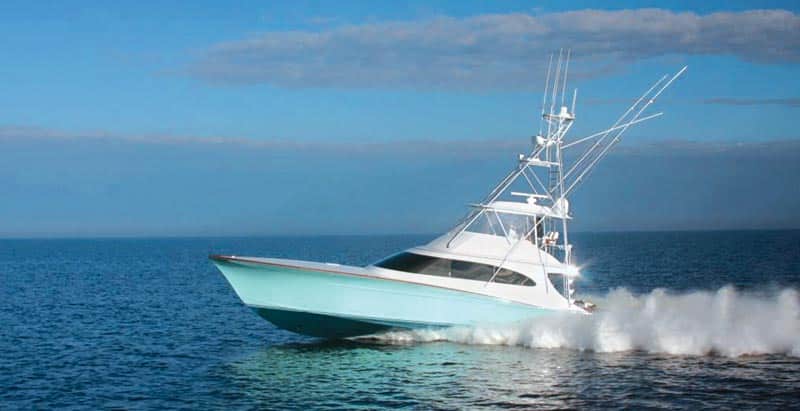
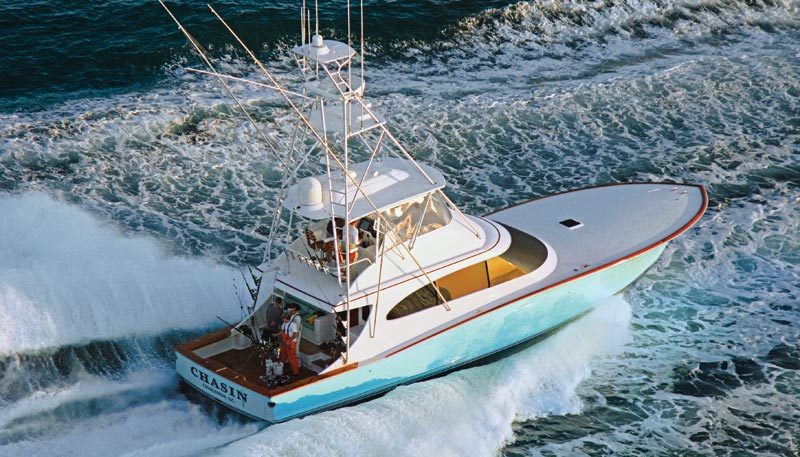
Spencer 60 Boat Review
Paul Spencer and his son, Daniel, are progressive builders, coming up with ingenious uses of the new pod power and out-of-the-norm design features. And yet Spencer’s boats still unequivocally qualify as classic Carolina boats. This sea trial proved particularly interesting, as I got to see two different owners’ takes on the same hull!
Performance
Spencer Yachts is as famous for building fast boats as it is for pushing the envelope in design and propulsion innovation. Both Chasin and Stream Weaver qualify as rocket ships, with top-end speeds well in excess of 40 knots. But with all of the additional appointments on Chasin, the boat weighs considerably more than Stream Weaver, yet with the added weight and a full tower, it gives up only about 2 knots on top-end.
Hatteras Inlet changes daily. Without local guidance, it’s a rough, scary and dangerous place. With the wind against the tide, seas crossing the bar ran from four to 12 feet, depending on the depth and where we were in the channel. We slowed to 19 knots for the worst of it, but otherwise, in the four- to five-foot stuff, we blasted through at 30!
Outside, in four- to six-footers with longer periods, the spray came up over the flybridge when we cruised slowly along, but when we throttled up to 31 knots, the spray didn’t even touch the boat anymore. The spray crossed the transom instead.
The Spencer 60 carves through head seas like a knife through soft butter, with absolutely no slowing or sense of impact. The same applies to running down-sea. Roll moment is remarkably short with extremely gentle transitions. We backed up-sea to get water in the cockpit, and when we shifted to forward, the half-full cockpit drained instantly. Down-sea, it backed straight at 7.5 knots.
Back inside in calm water, and with a bit of a tail-current, we hit 47.5 knots at 2,350 rpm — but were still only burning 160 gph! Stream Weaver took 10 seconds to plane and 18 seconds to reach 30 knots with the 1,650-horsepower CATs coupled to a pair of Veem Interceptor props. At 40 knots (60 percent load), we burned 120 gph. I threw the wheel hard over at 31 knots, and Stream Weaver reversed course in a mere 2½ boat lengths. It handles like an overgrown F-22 Raptor!
Engine Room
All Spencer boats come with surgically clean engine compartments — all surfaces here and elsewhere aboard have been coated with Alexseal paints.
In a nod to real-world possibilities, the company also put a crash pump on each engine. Both boats offer plenty of room outboard of the engines to work. Chasin sports a pair of watermakers; Stream Weaver does not. The differences really all add up to one boat being a showpiece that fishes, while the other is a fishing boat that looks gorgeous — it runs like a scalded dog, but fishing is its absolute top priority.
Both boats have pumps and generators along the forward bulkhead, tunnels from the compartment to the lazarette for additional storage and Livos air handlers. The engine stringers have aluminum caps as well as additional aluminum plates for the engine mounts to tap into.
Interior
On Chasin, the computer uses the big-screen TV as its monitor, and the keyboard, printer, fax machine, etc., are all wireless. Stream Weaver doesn’t have a computer on board. The boats have identical hulls, but that’s where the similarities end. Chasin controls all the electrics via Octoplex monitors throughout the boat. Also, forward of the captain’s cabin to starboard, Spencer installed a “trophy case” rod locker with a glass door, architectural lighting and carpeting on the bulkheads. It even boasts Rainbird showerheads flush-mount in the shower ceilings, eliminating the shower wand with the flexible hose.
Chasin has a fairly standard array of cabins with singles and doubles — all with innovative and copious storage areas, especially for tackle. The bulkheads are made with beautiful wood veneers over Tri-cell coring.
Stream Weaver, however, sports padded wall treatments on the bulkheads. Eschewing flash and luxury, Stream Weaver turns out more like a gorgeous, upscale day boat. Where Chasin features a double cabin to starboard, Stream Weaver’s amidships space to starboard consists of a huge open tackle room with all the rods and reels mounted on the bulkheads. Floors here are all Amtico composite flooring, where Chasin sports real teak and holly. Chasin comes with a well-equipped galley with cooktop and lots of storage and a dinette. Stream Weaver has no dinette and precious little in the way of cooking gear — in fact, it’s limited to a microwave.
Flybridge
Both bridges offer straightforward layouts with straight settees to one side and L-shaped to the other. The owner put two sets of teaser reels on Stream Weaver for running dredges and squid chains. I liked the engine displays mounted on the helm pod so you never have to crane your neck upward to see what your power is doing.
By now, everyone has seen the cool magnets and plates to hold doors and hatches open. Spencer takes that a step further by laminating the two pieces into the glossy hatch or door where you can’t see it, and yet they still work like magic.
A freshwater hose on the flybridge stows under the aft end of a straight settee, so the captain can stand at the helm and hose down the interior of the bridge on the way back to the dock. A handsome design element here — and elsewhere — is the tumblehome on many surfaces, such as the sides of the helm console.
You’ll find precious few straight, flat surfaces aboard. PipeWelders supplies the hardtops, outriggers and towers to Spencer, and Release Marine builds the helm and the companion and fighting chairs.
Cockpit
On Chasin the cockpit bulkhead was built a foot farther aft than usual for more interior space, while on Stream Weaver it was placed a foot farther forward to gain cockpit fishing room. Consequently, Stream Weaver’s cockpit seems to be triple the size of Chasin’s. In contrast, Chasin boasts a standard mezzanine with a step and seating stretching into the pit. Stream Weaver does away with the step, harking back to modules with nonskid cushions on top for seating. Another dramatic difference here is Stream Weaver’s flybridge ladder, which mounts directly to the aft cabin bulkhead and requires you to climb onto the module seat and then up to the bridge. In a burst of descriptive brilliance, Daniel Spencer dubbed the modules on Stream Weaver “mezzaboxes.” Yet another retro feature the owner fought for is the centerline cabin door. Most builders prefer the door at one side or another to add to seating space along the aft bulkhead.
Design and Construction
Spencer constructs his solid, cold-molded hulls with three layers of Okoume plywood, sandwiching three layers of nine-millimeter fiberglass between each layer in the bottom and six millimeters in the topsides. It’s all bonded together with epoxy. While I realize that many owners like the sleek look of a glossy foredeck, as crew, I appreciate that Chasin comes with an all-nonskid foredeck. Yes, I know it’s harder to keep clean. I don’t care.
From the basic layout to the livewells and storage to living quarters, the benefit of a custom boat is that you, the owner, can dictate exactly what you want — and a successful builder makes it happen! And by the way, Chasin marks the 75th boat from Spencer.
So, for this test, I encountered two boats, two owners, two very different worlds — and one very skilled boatbuilder who can do it all!
Specifications
LOA……60’6″
BEAM……17′
DRAFT……4’10” (Chasin) / 4’6″ (Stream Weaver)
WEIGHT……60, 300 pounds (Chasin) / 56,000 (Stream Weaver)
DEADRISE……9 degrees
FUEL……1,810 gallons (Chasin) (in three tanks) / 1,600 gallons (Stream Weaver)
WATER……270 gallons (Chasin) / 230 gallons (Stream Weaver)
GENERATOR……23 kW Caterpillar (Chasin) / 15 kW Phasor (Stream Weaver)
POWER……Twin 1,650 hp Caterpillar C32 Acerts
